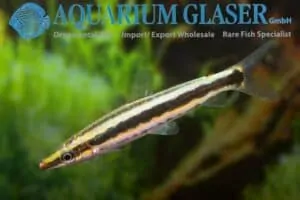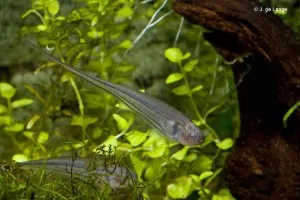Hyphessobrycon sweglesi – Red Phantom Tetra
Hyphessobrycon sweglesi was first described by Géry in 1961. Their common name is Red Phantom Tetra.
The genus name Hyphessobrycon can be broken down into two ancient Greek words. Hyphesson means “a little smaller” and “bryko” means biter. Together they form the genus name “Little Biter”.
The species name ‘sweglesi’ is in honor of Kyle Swegles, the owner of Rainbow Aquarium in Chicago. He was the one who captured the type specimens.
Description
The Red Phantom Tetra is a beautifully colored fish that will certainly stand out in the aquarium. Both the body and fins are colored red. On the flank, just behind the gill cover, they have a distinctive black spot. They are very similar to the Black Phantom Tetra, apart from the color of course.
Also, they resemble their relative Hyphessobrycon eques, at least in photos. Placed side by side in the aquarium, the difference is more apparent. The shape of the fish is different. The spot on the flank differs from each other. The body of Hyphessobrycon sweglesi is quite transparent with the intestines visible in a metallic color. The body of Hyphessobrycon eques is quite opaque. The difference can also be seen in the anal fin. Hyphessobrycon eques has a black band that is missing in the other Hyphessobrycon species. The species have been in different genera for years. I suspect that they will eventually belong to different genera again. New research will tell.
With a maximum total length of about 4 centimeters, Hyphessobrycon sweglesi is a small perennial species. They only feel comfortable when they are kept in a school. Keep in mind that you keep at least six copies together, but preferably many more.
In a new environment, they can withdraw a bit at first and hide among the plants. Once accustomed to their new environment, they are curious little fish that will explore the entire aquarium. They usually inhabit the middle part of the aquarium.
How do you see the difference between males and females in the Red Phantom Tetra?
You can tell the difference between the males and females by the dorsal and anal fins. The males have somewhat more elongated dorsal and anal fins. The body of the females is built somewhat higher than that of the males.
How old can Red Phantom Tetra get?
Normally, a Red Phantom Tetra can reach an age of about three to five years. In the aquarium, with good care, they can even grow a little older.
Biotope
You can find these fish in South America. They are found in the Rio Orinoco basin, mainly in the upper reaches and middle of this river. They avoid the main rivers and usually inhabit the tributaries such as Rio Apure, Rio Atabapo, Rio Capanaparo, Rio Caura, Rio Cinaruco, Rio Guaviare, Rio Inirida, and Rio Ventauri.
As mentioned, they avoid the large fast-flowing main river and look for smaller tributaries or the horseshoe parts of the river. They can also be found in the flood areas next to the rivers.
They inhabit both the clear water zones and the black water parts of the rivers. In the clear water parts, they choose the parts with many aquatic plants between which they can hide.
Depending on the origin, the wild-caught fish come from water with different acidity. This can have a slightly higher pH to pH 7.5 or more acidic from the blackwater parts with a lower pH to pH 5.5.
Diet
In the wild, the Red Phantom Tetra feeds on small invertebrates, crustaceans, but also algae and fruits that have fallen from trees and shrubs.
In the aquarium, it is not a picky eater. You can feed them with flake food, small granules. Alternate this with frozen or live food such as mosquito larvae, tubifex, brine shrimp, and daphnia. Make sure that some vegetable food is also given. This can be in the flake food or, for example, in the form of spirulina flakes.
If they don’t get enough greens, they can nibble on some soft plants. To prevent this, you can give a piece of cucumber or other soft vegetables. Remove this from the aquarium after an hour to prevent the vegetables from polluting the water.
The Aquarium
You can keep a school of these beautiful Red Phantom Tetras in an aquarium from 80 centimeters in length.
Set up the aquarium with (filter) sand on the bottom. Provide plenty of plants for the fish to hide and swim in. The red color of this species contrasts very nicely with the green of most plants. You can actually see them swimming between the plants in search of food.
These are real schooling fish. Keep them in a school of sufficient size, at least about 6 specimens, but they actually do better in a larger school. The males hold mock fights with each other to determine their ranking. This also attracts the attention of the females. The spectacle of the male’s mock fights is great fun to watch!
If they are kept alone or in a group that is too small, they become shy and disappear between the plants. Due to the stress, they are more susceptible to diseases and they languish.
Water parameters
They get their best colors and remain healthiest in relatively soft water with a low hardness of GH 1 to 12. Keep the pH neutral to acidic, between 4.5 and 7.5. You can also filter over peat to color the water slightly and to make it slightly softer and more acidic. The temperature may be between 20 and 28 degrees Celsius.
To imitate the (black water) biotope, put some leaf waste on the bottom. Infusoria come to life naturally between the leaves, which the fish can feed on.
What other fish can go with the Red Phantom Tetra?
This schooling fish is very suitable for a community aquarium, provided you take the fellow residents into account. They don’t get very big and that’s why it’s best to combine them with species that are about the same size.
Suitable co-inhabitants include Corydoras species on the bottom. On the surface, you could opt for a kind of freshwater hatchetfish. Pencil fish, for example, are also suitable.
As a bottom inhabitant, you could also opt for a small cichlid such as an Apistogramma or, for example, Mikrogeophagus altispinosus. It is better not to keep these Dwarf Cichlids together with Corydoras species. Both go well together with Armored Catfishes.
Breeding aquarium and conditioning
In a densely planted aquarium, you might just come across a young Red Phantom Tetra every now and then. The parents are egg scatterers. This means that they release their eggs between the plants and do not look back at them. However, most eggs and young fish are eaten. Only a few will survive.
Breeding Tank
If you really want to breed with this species, it helps to set up a special breeding aquarium separate from the aquarium with the parents. Set up the aquarium with a fine grid on the bottom where the eggs can fall in between and the parents can no longer reach them. A piece of artificial grass is also a suitable alternative to the grid. The eggs can then fall between the “blades of grass” so that the parents cannot reach them.
Use a large amount of fine-leaved plants such as Java Moss. A few spawning mops are also suitable. Between the leaves or the strands of the spawning mop, the parents deposit the eggs.
The breeding aquarium does not need to be lit. Rather put it in a somewhat darker place so that little or no light falls into it. As a filter you preferably use a sponge filter. The sponge ensures that the newly hatched fish are not sucked up. The water should be slightly more acidic with a pH of 6 to a maximum of 6.5 and a temperature of around 24 degrees Celsius.
Feed the parents with live food such as mosquito larvae and brine shrimp for a few days.
Allow the aquarium to mature properly. The young fish look for the smallest living food among the plants.
The Spawn
As soon as the female is well fat with eggs, choose the most beautiful one or two males and a number of females. Put them in the breeding tank in the evening. Usually the next morning the eggs are deposited between the fine-leaved plants or between the strands of the spawning mop.
It is quite obvious when the fish are busy laying the eggs. The male continues to swim right next to the female as they make sharp turns between the plants.
The female releases up to about 200 eggs, which are fertilized by the male. The small eggs are red/brown in color. After the eggs have been laid, you can place the parents back in their own aquarium.
The eggs are sensitive to light! Cover the aquarium slightly so that they do not become moldy.
Raising the fry
The eggs of the Red Phantom Tetra hatch after 24 to 36 hours. After three to six days, the young fish can swim freely and mainly hide among the plants.
At first they are so small that they can only eat the smallest food. So make sure that you grow infusions on time and have them ready.
The young fish grow slowly. Over time you can switch to slightly larger food such as brine shrimp nauplii and dust food or crushed flake food.
Conclusion
The Red Phantom Tetra is a very peaceful schooling fish. They are suitable for the community aquarium. The breeding of this species is quite possible, but it does require some attention in terms of water parameters, but also to light because the eggs are light sensitive. It is definitely worth trying to breed them!
Video
Author
John de Lange
Copyright images
Hristo Hristov
F. Ingemann Hansen – Akvariefotografen.com
References
Seriouslyfish
Fishbase
Badmanstropicalfish











Reviews
There are no reviews yet.